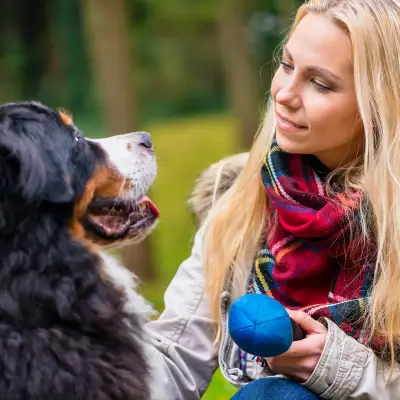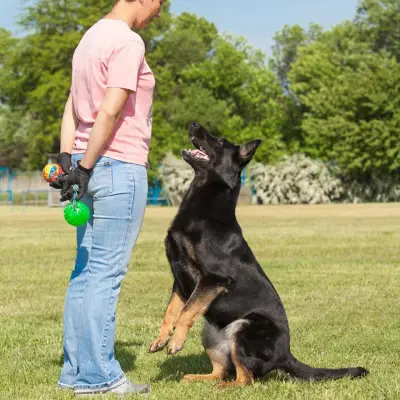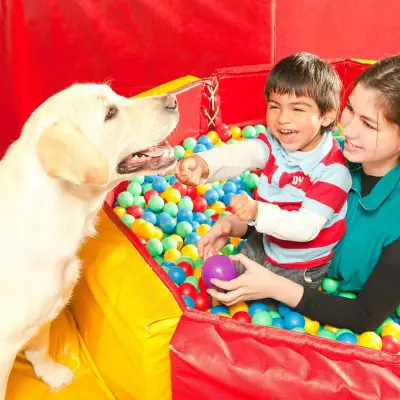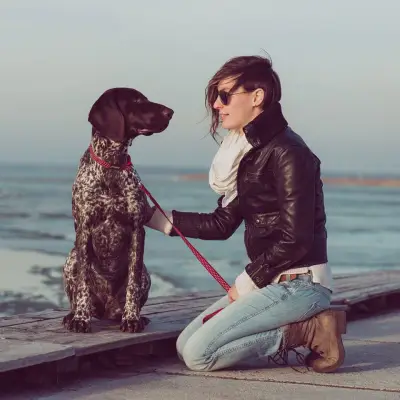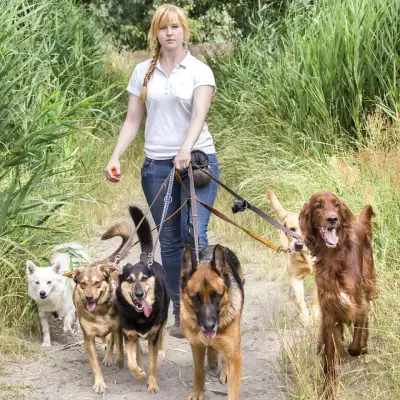Bringing a second dog into your home can be a wonderful experience. But, while the idea of doubling the love, fun, and furry antics is exciting, it also comes with its own set of considerations and challenges.
Whether you're pondering the question, "Should I get another dog?" or you've already decided to enhance your furry family, understanding how to make this transition as smooth as possible is essential. This blog post guides you through introducing two dogs to ensure they get along, creating a harmonious and happy household for everyone involved.
Jump to:
Are Dogs Happier With Another Dog?
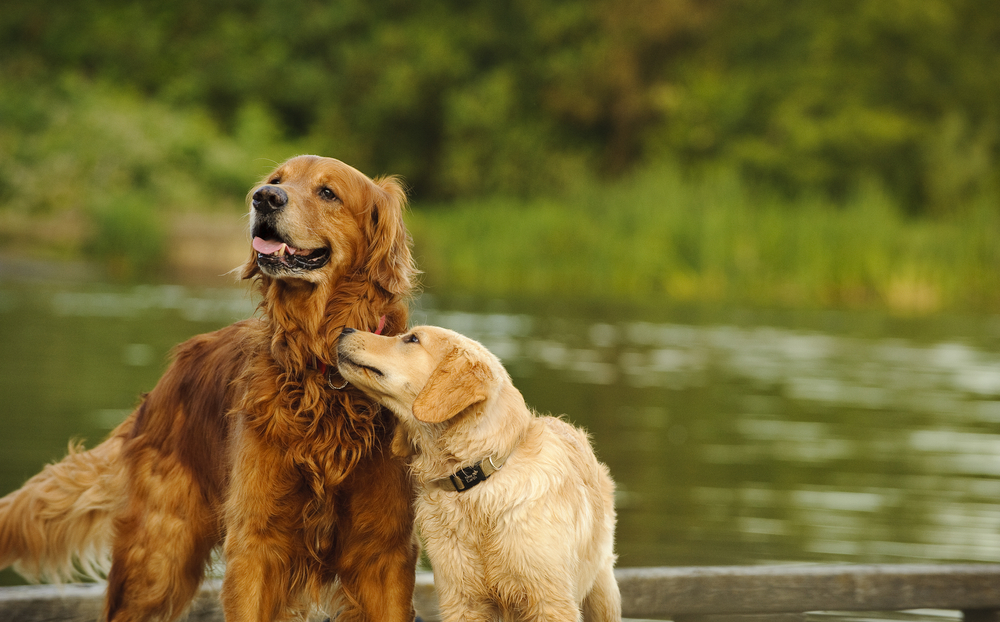
The answer often depends on the individual dog's personality, but many thrive with the companionship, reducing anxiety and boredom while you're away. Yet, the leap from having one dog to owning two is significant, so weighing the pros and cons of getting a second dog is an important first step.
Getting another dog involves more than doubling the food and toys. It requires thoughtful consideration of your current dog's temperament, the new dog's age, and how these factors will blend into your family dynamic. Are two dogs better than one? They can be if both dogs’ personalities complement each other and you have the resources to care for them both.
What to Consider Before Getting Another Dog
When contemplating getting a second dog, several factors should be key in your decision-making process. It's about ensuring a harmonious balance that enriches the lives of all involved, including your first pet. Here are some considerations:
- Your Current Pet's Age: Older dogs may benefit from the vitality of a puppy, which can invigorate their routine and bring a sense of youthfulness back into their life. However, the age difference could also lead to irritation or stress if the older dog prefers quiet.
- Energy Levels: Consider the energy level of your current dog compared to the potential new addition. A high-energy dog might overwhelm a more sedate, laid-back dog, causing friction.
- Sociability: How well does your current dog get along with other dogs? If they enjoy the company of canine friends on walks or in the park, they're more likely to welcome a new sibling. Conversely, a dog who prefers human company might struggle to adjust.
- Puppy or Adult Dog?: Puppies require a lot of attention, training, and patience, especially in the first few months. If your current dog is very patient and nurturing, they might be a good match for a puppy. On the other hand, an adult dog might be better suited to households looking for a calmer addition or for older dogs who might not appreciate the high energy of a puppy.
- Capacity for Training and Attention: Introducing a new dog into your home means dividing your attention and possibly dealing with training from scratch. Assess whether you have the time, patience, and energy to train a new dog, especially a puppy.
- Compatibility: Consider the temperament and personality of your current dog and the potential new addition. Some breeds or individual dogs are naturally more friendly and may integrate more easily, while others might take longer to adjust.
How to Introduce Two Dogs
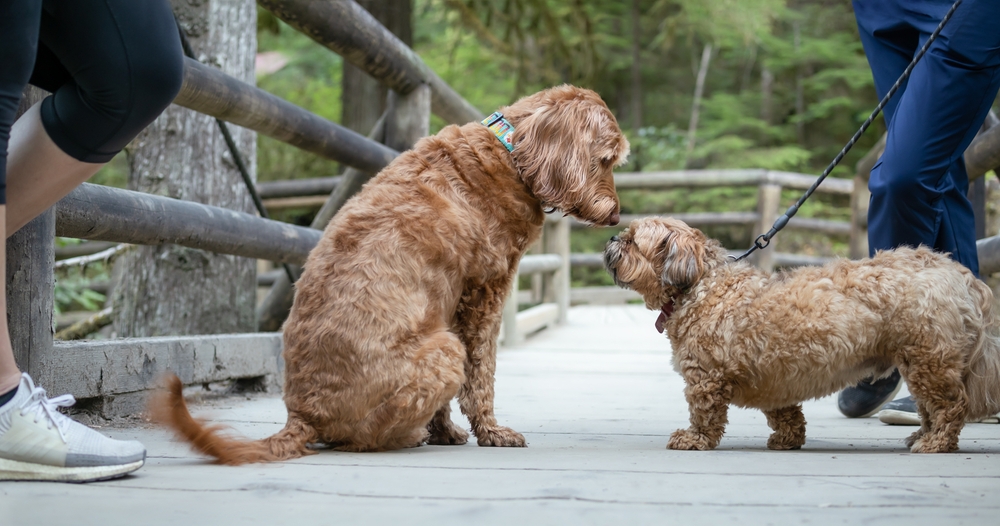
Introducing two dogs requires patience, understanding, and a bit of strategy. Here are steps to ensure a smooth introduction:
1. Meet on Neutral Ground
Choosing a neutral meeting place is the first important step in the introduction process. This approach minimises territorial instincts that might cause tension or aggression. Neutral grounds like a quiet park, an empty playground, or a friend's garden where neither dog has laid claim can set the stage for a more relaxed first encounter.
Both dogs should be kept on leashes during this meeting, but with enough slack to move freely. This controlled setup allows them to explore each other's scents and body language without the immediate pressure of establishing dominance or territory. Keeping the vibe positive and calm is essential, encouraging a friendly interaction from the get-go.
2. Monitor Their Body Language
The silent cues dogs give off through their body language can tell a lot about how they feel towards each other. Positive signs include relaxed ears, wagging tails (particularly those wagging in a relaxed manner at mid-height), and a general loose, playful posture. These indicators suggest curiosity and openness to friendship.
On the flip side, signs of discomfort or aggression, such as growling, stiff body postures, or raised hackles, signal that one or both dogs feel uncomfortable with the interaction. Recognising these signs early on can help you intervene before any tension escalates.
3. Take Things Slow
Rushing the process of making two dogs comfortable with each other is a common mistake. Even if the first meeting goes exceptionally well, it's important to gradually increase their time together, always under careful supervision. This might mean short, frequent visits in the beginning, slowly extending the duration as the dogs show signs of comfort and acceptance with one another's presence.
The key here is to allow natural relationships to form without forcing interactions, understanding that each dog is unique and will adjust at its own pace. Some pairs click almost instantly, while others may need weeks or even months to fully accept each other.
4. Create The Right Living Environment
Creating a living environment that encourages harmony among your dogs involves thoughtful preparation and adjustments to your home. This includes providing separate beds, toys, and feeding areas in the initial stages to prevent resource-guarding issues.
Ensuring each dog has its own safe space to retreat and relax without the other's presence is also essential. As they grow more comfortable with each other, you can encourage shared spaces and joint playtimes, always monitoring for any signs of discomfort.
5. Ensure Equal Love and Attention
Balancing affection and attention between two dogs can be challenging but is essential for their emotional well-being. Each dog should feel valued and cared for without feeling the need to compete for your love. This means dedicating individual time for walks, play, training, and group activities that foster a sense of pack and belonging.
Acknowledging each dog's achievements and milestones individually helps to strengthen your bond with them, reinforcing their importance in your life and your home.
6. Maintain Training and Consistency
Consistency in training and household rules plays a role in ensuring peace between your canine companions. If you're introducing a new dog into your home, it might be a good opportunity to refresh your first dog's training, reinforcing basic commands and behaviours.
For the newcomer, basic obedience training helps establish communication and expectations. Should any signs of aggression arise, professional help from a certified dog trainer or behaviourist may be necessary to address these issues safely. This ensures that both dogs understand their boundaries and the behaviour that is expected from them within the family dynamic.
7. Offer Plenty of Space and Resources
Ensure each dog has its own space, including beds, bowls, and toys, to avoid competition. The idea is to reduce potential competition that could lead to conflict between the dogs. For a puppy, having a designated safe space is particularly important.
Puppies have high energy levels but also require plenty of rest. Their own space offers a sanctuary for downtime, away from the curiosity or potential annoyance of an older dog. By clearly defining these resources and spaces from the outset, you lay the groundwork for respectful and stress-free coexistence between your canine companions, allowing them to feel secure and valued in their shared environment.
When Challenges Arise
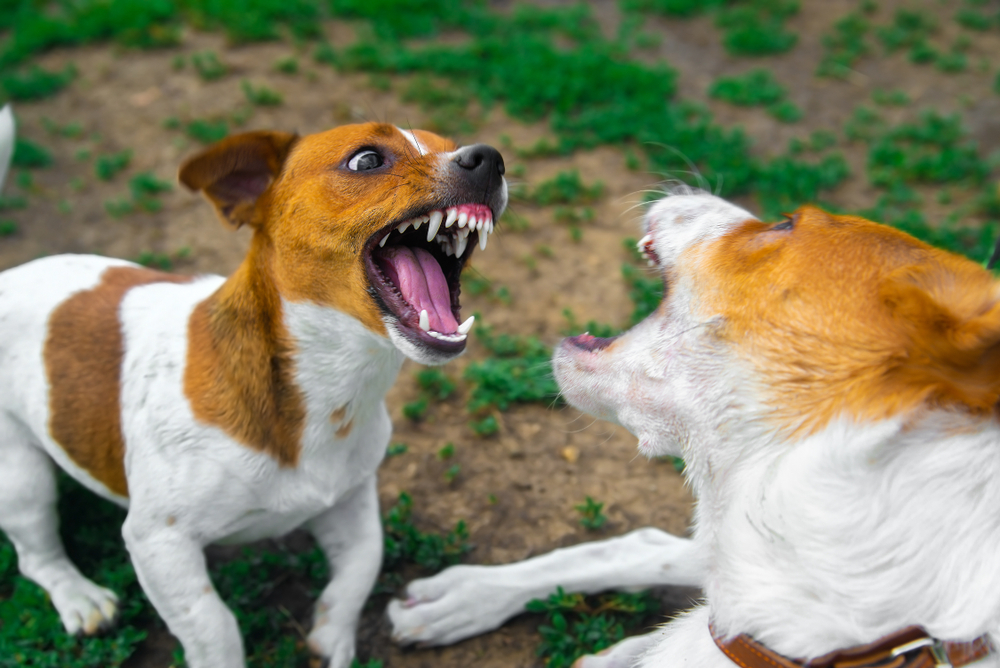
Despite your best efforts, there may be times when your dogs don't get along perfectly. Understanding how to navigate these situations is important.
Jealousy and Resource Guarding
Jealousy and resource guarding are frequent challenges in multi-dog households. Dogs may guard food, toys, or even people, viewing the new or existing pet as a rival for these valuable resources.
The key to overcoming this is to teach your dogs that resources are plentiful, and that sharing brings positive experiences. Training sessions that reinforce positive behaviour when resources are shared can be highly effective. In some cases, enlisting the help of a professional trainer or behaviourist is necessary to guide you through more complex or ingrained behaviours safely.
Adjusting to a New Puppy
Bringing a new puppy into a home with an older dog requires careful management to ensure both pets adjust well. Supervise their interactions and provide the older dog with breaks and private space. This helps manage the new puppy's energy levels, preventing them from overwhelming the older dog and ensuring the senior pet doesn’t feel ousted from their established territory or routine.
Establishing Boundaries
Dogs, like people, need to understand their boundaries within the home. Establishing these boundaries early on helps prevent conflicts. This could mean setting clear rules about where each dog can sleep, eat, or play. Using gates or crates to manage space effectively can also help create a structured environment where each dog feels secure and valued.
Handling Aggression
Aggression, whether from the existing dog or the newcomer, is a serious challenge that requires immediate attention. Signs of aggression can include growling, snapping, or outright fighting. It's important to address these behaviours promptly by identifying triggers and working to eliminate them. This might involve structured reintroduction sessions, behaviour modification training, or seeking assistance from a canine behaviour specialist. Never punish dogs for aggression, as this can exacerbate the problem; instead, focus on positive reinforcement and gradual desensitisation to triggers.
Overcoming Fear and Anxiety
Fear and anxiety can also manifest when introducing a new dog into your household. This could be due to past experiences, lack of socialisation, or simply the stress of adapting to a new member. Providing a safe, quiet space for each dog can help alleviate anxiety. Additionally, gradual exposure to each other in controlled, positive circumstances can help build confidence and reduce fear.
Ensuring Individual Attention
One challenge that can often be overlooked is ensuring each dog receives enough individual attention. Dogs thrive on one-on-one interaction with their owners; without it, they may feel neglected or compete more fiercely for attention. Make time for individual walks, play sessions, and training for each dog to reinforce their bond with you and their place in the family.
Common Questions About Introducing Two Dogs
What Should I Do If One Dog Is Constantly Dominating the Other?
It's natural for dogs to establish a pecking order, but excessive dominance from one dog can lead to stress and anxiety in the other. Encourage positive interactions with rewards and separate them if play turns too rough. Consistency in training and interventions can help manage and balance their relationship. If the dominant behaviour persists, consulting a professional dog trainer or behaviourist may be necessary.
Can Different Breeds of Dogs Live Harmoniously Together?
Dogs of different breeds can live together harmoniously. The key is matching their energy levels, temperaments, and personalities rather than focusing solely on breed. Proper introduction and ongoing socialisation are crucial in fostering a peaceful coexistence.
How Can I Ensure Both Dogs Get Enough Exercise?
Each dog's exercise needs vary based on age, breed, and health. Plan individual walks or play sessions to cater to their specific needs and group activities that help them bond. This ensures both dogs remain physically and mentally stimulated, reducing potential behaviour issues from boredom or excess energy.
What If My Dog Is Not Used to Sharing Their Home?
Introduce the concept of sharing gradually. Start by introducing the new dog's scent before they physically enter the home. Then, supervise short, positive interactions in neutral spaces. Increase their time together slowly, allowing your first dog to adjust at their own pace. Providing separate personal spaces and belongings can also ease the transition.
How Should I Handle Feeding Times to Prevent Conflict?
Feed your dogs at the same time but in separate areas to avoid competition over food. This helps establish a routine while ensuring they don't feel threatened or the need to guard their meals. Monitoring their behaviour during meal times can also help you adjust their feeding setup as needed to maintain a peaceful environment.
What Signs Should I Look for to Know They Are Getting Along?
Look for relaxed body language, playful interactions, and a willingness to share space and resources. Mutual grooming, lying together, and calm coexistence are strong indicators of a positive relationship. However, remember that building this bond can take time, and occasional squabbles don't necessarily mean they aren't getting along.
How Do I Know If It's the Right Time to Get a Second Dog?
Consider your current dog's age, health, and temperament, alongside your ability to provide time, attention, and resources for another pet. If your current dog is well-adjusted and social, and you can meet both dogs' needs, it might be a good time to introduce a new companion into your family.
Is It Better to Adopt a Dog of the Opposite Sex?
While there's no one-size-fits-all answer, some believe dogs of the opposite sex may get along better, minimising competition and dominance issues. However, personality and temperament are far more important factors. Spaying or neutering can also reduce potential conflicts related to hormonal behaviour.
How Long Should I Monitor Their Interactions?
Continue to monitor their interactions until you're confident they're comfortable with each other, which could take several months. Even then, it's wise to supervise playtime and check in on their dynamics regularly to ensure ongoing harmony and address any emerging issues promptly.
Recommended for you!
Best SellersUnderstand Canine Communication with Centre of Excellence
Learn more about dog behaviour with our Canine Communication Diploma Course, designed to help you better understand your furry friends.
Why Centre of Excellence?
- Accessibility: We believe education should be accessible to everyone. That's why we offer our courses at prices that make learning available to as many people as possible.
- Learn at Your Leisure: Our courses are crafted to fit into your life. Learn at your own pace and schedule, and weave your educational journey seamlessly into your everyday life.
- Supportive Learning Environment: Enrolment comes with personalised tutor support and access to a community of like-minded learners, providing a robust support network throughout your learning experience.
Exclusive Offer:
Enrol in our Canine Communication Diploma Course for the exclusive price of £29, saving you over £100!

